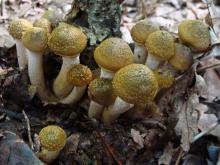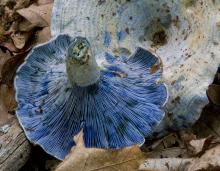Mushrooms
Media

Species Types
Scientific Name
Russula emetica
Description
The emetic russula has a uniformly red cap with off-white gills and stalk; its flesh and stalk are brittle. It grows singly or in groups, on moss and in mixed woods.
Media

Species Types
Scientific Name
Russula virescens
Description
Green cracking russula has a cap with a greenish, cracked, mosaic-like top, and cream-colored gills. It grows singly or in groups in mixed woods.
Media

Species Types
Scientific Name
Pluteus atricapillus (formerly P. cervinus)
Description
The fawn mushroom has a brownish gray cap with whitish to pinkish gills and a whitish stalk. It grows singly or scattered, on dead wood or on the ground over buried wood.
Media

Species Types
Scientific Name
Amanita vaginata
Description
The grisette has a gray cap with white patches and a radially grooved margin, and a stalk with a large, white, saclike cup around the base. It's found on the ground in open woods and in grass near trees.
Media

Species Types
Scientific Name
Chlorophyllum molybdites
Description
Green-spored lepiotas are large, white, with broad, cream-colored scales on the cap, white gills that turn gray-green, and a ring on the stalk. They grow in lawns and meadows, often in a circular arrangement called a "fairy ring."
Media

Species Types
Scientific Name
Armillaria mellea
Description
The honey mushroom has a honey-colored, sticky cap with black hairs over the center, and a stalk with a whitish ring. It grows in clusters at the bases of trees or stumps, especially oaks, and over buried wood.
Media

Species Types
Scientific Name
Lactarius indigo
Description
Entire mushroom bluish, bleeding blue; then greenish, bruising greenish. The indigo milky grows scattered or in groups on soil in oak and pine woods.
Media

Species Types
Scientific Name
Gymnosporangium juniperi-virginianae
Description
With their gelatinous orange tentacles, cedar-apple rust galls are one of Missouri’s freakiest sights in spring. Cedar-apple rust is a fungus with a two-part life cycle. Its two unrelated host plants are a juniper, such as eastern red cedar, and a tree in the rose family, especially apple and crabapple.
Media

Species Types
Scientific Name
Lycogala epidendrum
Description
Wolf's-milk slime looks like little, round, reddish pink balls that exude a pinkish-gray paste when popped. It grows in groups on dead wood, especially large logs. It's not really a mushroom!
Media

Species Types
Scientific Name
Fuligo septica
Description
In addition to "dog vomit" and "scrambled eggs," this slime mold can also look like the foam at the top of a pint of stout beer, or a yellow or tan sponge. It grows on mulch and other decaying wood.
See Also



Media

Species Types
Scientific Name
Monotropa hypopitys
Description
Pinesap is a plant that puts the "wild" in wildflower! It lacks chlorophyll, so its roots connect to fungi underground and absorb nutrients from the fungi.
Media

Species Types
Scientific Name
Cladophora, Pithophora, and Spirogyra spp., and others
Description
Filamentous green algae forms green, cottony masses that are free-floating or attached to rocks, debris, or other plants.
Media

Species Types
Scientific Name
Monotropa uniflora
Description
Indian pipe lacks chlorophyll, so it is white, not green. Below ground, its roots join with fungi that connect to tree roots. This plant, then, takes nourishment indirectly from the trees.
About Mushrooms in Missouri
Mushrooms are a lot like plants, but they lack chlorophyll and have to take nutrients from other materials. Mushrooms are neither plants nor animals. They are in a different kingdom — the fungi. Fungi include the familiar mushroom-forming species, plus the yeasts, molds, smuts, and rusts.
Always be cautious when eating edible mushrooms. Be absolutely sure of the ID, and only eat a small amount the first time you try it to avoid a reaction..





















